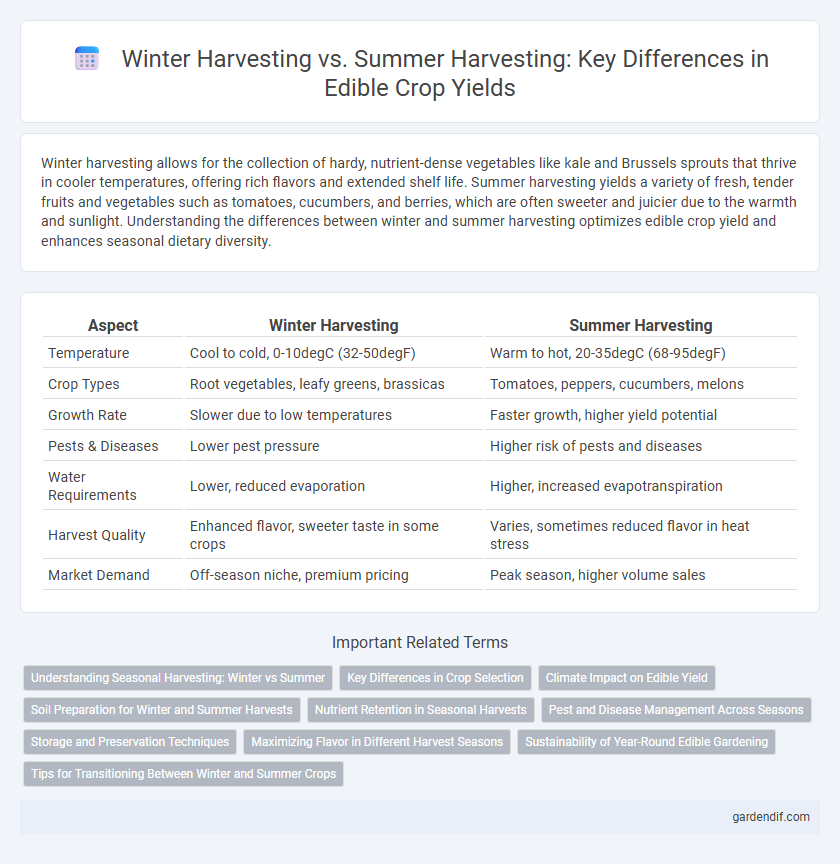
Winter harvesting vs Summer harvesting Illustration
Winter harvesting allows for the collection of hardy, nutrient-dense vegetables like kale and Brussels sprouts that thrive in cooler temperatures, offering rich flavors and extended shelf life. Summer harvesting yields a variety of fresh, tender fruits and vegetables such as tomatoes, cucumbers, and berries, which are often sweeter and juicier due to the warmth and sunlight. Understanding the differences between winter and summer harvesting optimizes edible crop yield and enhances seasonal dietary diversity.
Table of Comparison
| Aspect | Winter Harvesting | Summer Harvesting |
|---|---|---|
| Temperature | Cool to cold, 0-10degC (32-50degF) | Warm to hot, 20-35degC (68-95degF) |
| Crop Types | Root vegetables, leafy greens, brassicas | Tomatoes, peppers, cucumbers, melons |
| Growth Rate | Slower due to low temperatures | Faster growth, higher yield potential |
| Pests & Diseases | Lower pest pressure | Higher risk of pests and diseases |
| Water Requirements | Lower, reduced evaporation | Higher, increased evapotranspiration |
| Harvest Quality | Enhanced flavor, sweeter taste in some crops | Varies, sometimes reduced flavor in heat stress |
| Market Demand | Off-season niche, premium pricing | Peak season, higher volume sales |
Understanding Seasonal Harvesting: Winter vs Summer
Winter harvesting emphasizes cold-tolerant crops like kale, Brussels sprouts, and root vegetables, which develop enhanced flavors and higher nutrient density due to slower growth rates and frost exposure. Summer harvesting targets heat-loving produce such as tomatoes, peppers, and squash, benefiting from longer daylight hours and warmer temperatures that accelerate ripening and sugar accumulation. Understanding these seasonal differences informs optimal planting schedules and maximizes yield quality for diverse edible crops.
Key Differences in Crop Selection
Winter harvesting primarily focuses on cold-resistant crops such as kale, Brussels sprouts, and root vegetables like carrots and parsnips, which thrive in lower temperatures and shorter daylight hours. Summer harvesting favors heat-tolerant crops like tomatoes, cucumbers, peppers, and corn, benefiting from longer days and warmer soil conditions. Crop selection is driven by seasonal temperature, sunlight availability, and frost sensitivity, dictating optimal growing periods for maximum yield and quality.
Climate Impact on Edible Yield
Winter harvesting typically results in lower water usage and reduced pest pressure, leading to a more sustainable edible yield compared to summer harvesting. Cooler temperatures during winter slow down crop respiration, increasing biomass retention and nutrient density. Climate variations influence crop cycle length and productivity, making winter seasons advantageous for minimizing heat stress and maximizing edible yield quality.
Soil Preparation for Winter and Summer Harvests
Winter harvesting demands well-amended, nutrient-rich soil that retains moisture and promotes root growth despite cold temperatures, often enhanced with organic compost and mulch to insulate against frost. Summer harvesting requires soil that is well-drained and aerated, with balanced pH and adequate nitrogen levels to support rapid plant development in warmer weather. Understanding these seasonal soil preparation techniques boosts crop yield and quality for both winter and summer edible harvests.
Nutrient Retention in Seasonal Harvests
Winter harvesting preserves higher levels of antioxidants and vitamin C in vegetables due to slower metabolic rates and cooler temperatures, which reduce nutrient degradation. In contrast, summer harvesting often results in increased sugar content but may cause faster nutrient loss because of heat exposure and rapid plant metabolism. Choosing seasonal produce based on harvest time can optimize nutrient retention and enhance dietary benefits.
Pest and Disease Management Across Seasons
Winter harvesting reduces the prevalence of many common pests and diseases due to cooler temperatures slowing pathogen and insect activity. In contrast, summer harvesting faces increased challenges from rapidly multiplying pests like aphids and fungal diseases such as powdery mildew, requiring more intensive integrated pest management strategies. Effective seasonal pest control hinges on monitoring specific pest life cycles and adapting disease prevention methods to temperature and humidity fluctuations.
Storage and Preservation Techniques
Winter harvesting requires robust storage methods like root cellaring and cold storage to maintain produce freshness over extended periods, while summer harvesting benefits from quick preservation techniques such as freezing, canning, and dehydration to prevent spoilage due to higher ambient temperatures. Moisture control and temperature regulation are critical in winter storage to avoid mold and decay, whereas rapid cooling and vacuum sealing are essential in summer to lock in nutrients and extend shelf life. Utilizing seasonal harvesting strategies aligned with optimized preservation techniques enhances food security and reduces waste across different climate conditions.
Maximizing Flavor in Different Harvest Seasons
Winter harvesting enhances flavor intensity in crops like root vegetables and brassicas by slowing sugar metabolism, resulting in naturally sweeter and more robust tastes. Summer harvesting captures peak ripeness in fruits and leafy greens, preserving bright, fresh flavors and high nutrient content. Strategic timing and crop selection tailored to each season maximize flavor profiles and ensure optimal taste experiences year-round.
Sustainability of Year-Round Edible Gardening
Winter harvesting extends the growing season, reducing reliance on imported produce and lowering carbon footprints associated with transportation. Summer harvesting maximizes natural sunlight and warmth, optimizing plant growth and yield with minimal energy input. Combining both seasonal harvests promotes sustainability by maintaining soil health, reducing waste, and ensuring a continuous supply of fresh, local edibles throughout the year.
Tips for Transitioning Between Winter and Summer Crops
Transitioning between winter and summer crops requires careful soil preparation and selection of temperature-appropriate varieties to ensure crop resilience. Incorporate organic matter to improve soil fertility and structure, helping plants thrive during seasonal shifts. Monitor local frost dates and gradually phase out cold-tolerant crops while introducing heat-loving species for optimal edible garden yield.
Winter harvesting vs Summer harvesting Infographic

 gardendif.com
gardendif.com